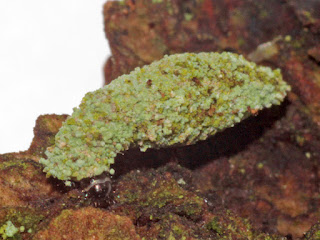A sunny afternoon walk round the Meadows on Friday afternoon was very productive. I found
3 Small Yellow Underwings (same fields but different places to last time) though I'm still not really happy with my photos - I just can't seem to get things like this fully sharp using my 7D - not sure why.
Small Yellow Underwings, North Elmham Cathedral Meadows, 18th May
Other half-decent moths included Hawthorn Bent-wing
Bucculatrix bechsteinella, Lead-coloured Drill
Dichrorampha plumbana and my first migrant at the meadows, a
Silver Y.
Hawthorn Bent-wing Bucculatrix bechsteinella, North Elmham Cathedral Meadows, 18th May
Lead-coloured Drill Dichrorampha plumbana (male, gen det), North Elmham Cathedral Meadows, 18th May
I counted at least
32 Cocksfoot Moths Glyphipterix simpliciella but they were everywhere and I expect I'd have found hundreds if not thousands if I'd looked hard enough. Other moths were Plain Gold
Micropterix calthella, Hawthorn Slender
Parornix anglicella, 6 Common Nettle-taps
Anthophila fabriciana and Red Twin-spot Carpet.
Plain Gold Micropterix calthella, North Elmham Cathedral Meadows, 18th May
Butterflies consisted of Small White, Green-veined White, 3 Orange-tips, Peacock and Speckled Wood, while my first Azure Damselfly of the year and 5 Large Red Damselflies made up the dragonflies.
Peacock, North Elmham Cathedral Meadows, 18th May
There were
2 Dock Bugs and my first 2 Red-and-black Froghoppers
Cercopis vulnerata for the site. Also a
Leptopterna nymph, I suspect
dolabrata but I don't think you can rule out
ferrugata at this stage (let me know if I'm wrong about that).
Red-and-black Froghoppers Cercopis vulnerata, North Elmham Cathedral Meadows, 18th May
Leptopterna sp. nymph, North Elmham Cathedral Meadows, 18th May
Two beetles were both completely new species for me. I've not been doing beetles that require microscopic examination for very long so new beetles are quite a regular feature for me, but one of these was a ladybird, the distinctive examples of which I have been identifying for quite a few years, so a new ladybird is a much more satisfying and exciting find. It was a
24-spot Ladybird, a species with a scientific name that's way too long:
Subcoccinella vigintiquattuorpunctata, though I see some sources transcribe it simply as
Subcoccinella 24-punctata.
24-spot Ladybird, North Elmham Cathedral Meadows, 18th May
I don't think it's especially uncommon, but uncommon enough for me not to have noticed it before. The other new beetle was one that required close examination, indeed I think I may have seen it before and misidentified it even after microscopic examination. I eventually figured out that it was
Polydrusus cervinus, a species that, unlike several other similar species, is not always a metallic green colour. I was initially put off by its colour, thinking it must be one of the other
Polydusus or
Phyllobius species but in the end
cervinus seemed to be the only species that ticked all the boxes, and it turns out they are quite often this green. One or two of the other features were quite hard to see too, and I wonder if I may have got these wrong in the past as they're meant to be very common indeed.
Polydrusus cervinus, North Elmham Cathedral Meadows, 18th May
Hoverflies included another
Melanostoma mellinum and a new species for me,
Sphaerophoria interrupta.
Sphaerophoria interrupta, North Elmham Cathedral Meadows, 18th May
I found a number of ants on a tree trunk and then swept some more off some nearby Common Vetch. I was sure they were not one of the two species I'd identified up to now and sure enough they proved to be Negro Ants
Formica fusca. There was also a Common Red Ant
Myrmica rubra among them.
Negro Ants Formuca fusca, North Elmham Cathedral Meadows, 18th May
Bees included Flavous Nomad Bee
Nomada flava, Red-tailed Bumblebee and Common Carder Bees.
Flavous Nomad Bee Nomada flava, North Elmham Cathedral Meadows, 18th May
This spider seems to be
Tetragnatha montana I believe...
Tetragnatha montana, North Elmham Cathedral Meadows, 18th May
Some nice flowers too, including these
Hedgerow Cranesbill and
Star-of-Bethlehem.
Hedgerow Cranesbill, North Elmham Cathedral Meadows, 18th May
Star-of-Bethlehem, North Elmham Cathedral Meadows, 18th May
A while ago I posted about an algae-covered larva I found at Bittering on 13th April. I'd initially identified it as either Virgin Bagworm
Luffia ferchaultella or White-speckled Bagworm
Narycia duplicella, both of which have similar algae-covered larvae. For reasons that I can no longer recall or fathom, I eventually plumped for the former and recorded it as
Luffia ferchaultella.
It soon ate all the algae on the bit of bark I collected it on, so I returned to gather some more and put it in the pot with it. After a few days it stopped munching and remained still - I wasn't sure if it had died or pupated, but kept it sitting on my desk and checked it daily. On 19th May I looked again and noticed a change - protruding from the tip of the case were what looked like clear wings. There was no sign of life though and I wondered if it had died on emergence - I hadn't at that point noticed any live insect in the pot. I checked a bit harder and was pleased to see a moth sitting still on the bark. Now
Luffia ferchaultella is a parthenogenetic species and only wingless females are known. This insect had wings, so it wasn't
ferchaultella after all - it was
Narcycia duplicella. Anyway a first for me, not only a new species but the first time I've ever successfully reared a moth from a larva.
White-speckled Bagworm Narycia duplicella larva, Bittering, 13th April
White-speckled Bagworm Narycia duplicella reared from the above larva, 19th May













































































